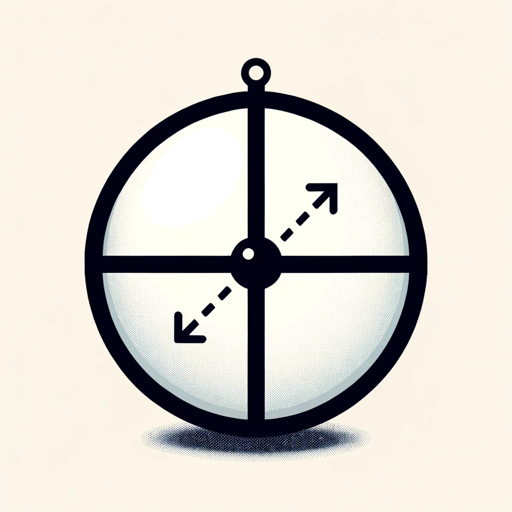Quantum Mechanics-Quantum Mechanics Knowledge Source
AI-Powered Quantum Mechanics Assistance
What's a fascinating fact about Niels Bohr?
Can you suggest a simple quantum experiment for beginners?
What are the latest advancements in quantum computing?
How does quantum mechanics relate to biology?
Related Tools
Load More
QuantumGPT
Quantum Computing tutor and Qiskit code assistant.

Quantum Mechanics Problem Solver
Expert in solving and explaining quantum mechanics problems step-by-step.

Quantum Mind
Ask unsolved math equations or science question. Try it out yourself and believe me you will be shocked

Quantum Mentor
Academic guide for quantum and math concepts.

Science of Intelligence Expert
Expert on 'Science of Intelligence' with a focus on AI, quantum mechanics interpretations, and intelligence, including the concept of Quantalogue from Chapter 6.

Quantum Mechanics I Physics Tutor
Tutor for Graduate Quantum Mechanics I, explaining complex concepts in detail.
20.0 / 5 (200 votes)
Introduction to Quantum Mechanics
Quantum Mechanics is a fundamental theory in physics that describes the physical properties of nature at the scale of atoms and subatomic particles. It is designed to explain phenomena that cannot be accounted for by classical mechanics, such as the behavior of particles at the quantum level. One of its primary functions is to provide a framework for understanding the dual wave-particle nature of matter and energy. For example, the double-slit experiment illustrates how particles like electrons exhibit both wave-like and particle-like properties, depending on how they are observed.

Main Functions of Quantum Mechanics
Wave-Particle Duality
Example
Double-slit experiment
Scenario
When electrons are fired at a barrier with two slits, they create an interference pattern on a screen behind the barrier, demonstrating their wave-like behavior. However, when observed at the slits, they behave as particles, passing through one slit or the other.
Quantum Superposition
Example
Schrödinger's Cat thought experiment
Scenario
A cat is placed in a sealed box with a radioactive atom, a Geiger counter, and a vial of poison. According to quantum mechanics, until the box is opened and an observation is made, the cat is in a superposition of both alive and dead states.
Quantum Entanglement
Example
EPR paradox
Scenario
Two particles become entangled, meaning the state of one particle is directly related to the state of another, no matter how far apart they are. Changes to one particle instantly affect the other, as demonstrated by experiments confirming Bell's Theorem.
Ideal Users of Quantum Mechanics
Physicists and Researchers
Physicists and researchers use quantum mechanics to explore fundamental questions about the nature of reality, develop new technologies like quantum computing, and conduct experiments that push the boundaries of our understanding of the universe.
Engineers and Technologists
Engineers and technologists apply principles of quantum mechanics in developing advanced technologies such as semiconductors, lasers, and quantum computers. Their work relies on the precise control and manipulation of quantum states to create innovative solutions.

How to Use Quantum Mechanics Tool
Visit aichatonline.org for a free trial without login, also no need for ChatGPT Plus.
Start by visiting the website to access the tool. The platform offers a free trial that doesn’t require any login or subscription to ChatGPT Plus.
Familiarize Yourself with the Interface
Explore the user-friendly interface and navigate through the various options available. Familiarity with the interface will help you utilize the tool effectively.
Identify Your Use Case
Determine the specific quantum mechanics-related problem or question you need help with. This could range from theoretical explanations to practical applications or academic research.
Input Your Query or Topic
Enter your specific query or topic into the tool. Be as detailed as possible to receive comprehensive and relevant answers.
Review and Utilize the Output
Analyze the output provided by the tool. Use the detailed information, explanations, and recommendations to advance your understanding or solve your specific problem.
Try other advanced and practical GPTs
Pun Innovator by Merch Momentum
AI-powered puns for your merch

Recruiter Coach
Enhance Your Recruitment with AI

Gyneco Obstetrics Expert
AI-Powered Insights for Gynecology-Obstetrics.

Instagram Post Writer
AI-Powered Social Media Content Creation

Studytube Copywriter
AI-driven content tailored for your brand.

Bible Study Buddy
AI-powered Scripture Insight Tool

Neovim GPT | Nvim Setup Assistant
AI-powered Neovim configuration assistant.

Accounts Advisor UK
AI-powered UK tax and accounting insights

Dr. GPT
AI-powered tool for medical professionals

Flutter Pro
AI-powered Flutter development assistant

Flutter
Build beautiful apps with AI-powered speed
Sing Song Song Maker
Create Your Own Songs with AI

- Research
- Education
- Analysis
- Innovation
- Technology
Common Questions About Quantum Mechanics Tool
What types of questions can I ask?
You can ask a wide range of questions related to quantum mechanics, including theoretical concepts, historical developments, recent breakthroughs, practical applications, and more.
How accurate is the information provided?
The tool leverages a comprehensive database and advanced algorithms to provide accurate and reliable information. However, it’s always good practice to cross-check critical data.
Can this tool help with academic research?
Yes, the tool is designed to assist with academic research by providing detailed explanations, relevant literature recommendations, and insights into complex quantum mechanics topics.
Are there any prerequisites to using this tool?
No specific prerequisites are required. However, a basic understanding of quantum mechanics principles can enhance your experience and help you make the most of the tool’s capabilities.
Can I use this tool for real-world applications?
Absolutely. The tool offers practical guidance and detailed steps for applying quantum mechanics principles in various real-world scenarios, from technology development to scientific research.